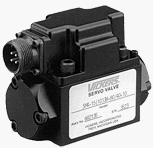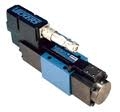Servo-controlled Valve Types
"The basic decision is whether to use servovalves or proportional valves. The main difference between them is how the spool is shifted. Proportional valves use an electric coil and magnet, like the voice coil of a typical audio speaker, to directly move the spool. Servovalves use a small torque motor to control hydraulic pressure, which in turn moves the spool (pilot-actuated).
The response of these two valve types differs because of the force available to shift the spool. Servovalves generally respond faster than proportional valves because of the ratio of hydraulic forces to the mass of the spool, although some proportional valves approach servovalve response times. Proportional valves must supply enough force to move the spool, the inline LVDT, and the solenoid core, as well as overcome spring centering forces.
The precise machining and small orifices associated with pilot-operated servovalves drive up the cost and make them more susceptible to contamination. In many applications, this has steered people away from servovalves and toward proportional valves. However, servovalves still have their place. For example, servovalves often work better on high-flow applications, where system pressure is available to move the spools and oppose the higher flow forces. In these types of applications, servovalves are a safer design choice and perform better because they have a faster and more linear response (and hence are easier to control)."
Source: Hydraulics/Pneumatics Magazine

